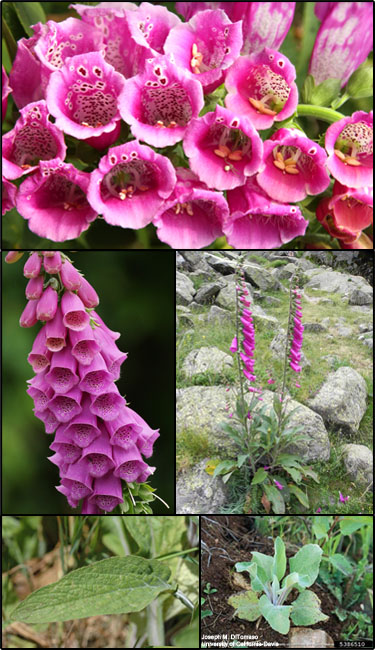Purple foxglove (Digitalis purpurea)
 Common Names: Foxglove
Common Names: FoxgloveDescription: Original source of the drug, digitalis. Highly toxic; fatal if eaten.
Habit: Biennial or short-lived perennial; herbaceous; ranges from 2-6 ft tall.
Leaves: Alternate, stem leaves lance-like, hairy below, progressively smaller up the stem.
Stems: Erect; ranges from 2-6 ft tall; grows from basal rosettes.
Flowers: Purple/white in color, 5-parted, 1 1/2-2 in long, upper lip not covering 4 stamens, lower lip only slightly longer and spotted with dark purple inside; tubular with bell-shaped opening, inflorescence a terminal cluster (raceme), stalked flowers often from only one side of the stem.
Fruit and seeds: Seed pod, oval to round, splits open at maturity, numerous 0.1-0.2 mm seeds.
Habitat: Native to Europe. Found along roadsides, disturbed areas, moist meadows, open woodlands and pastures.
Reproduction: By seed. Viable for at least 5 years.
Similar species: Straw foxglove (Digitalis lutea) and species of Beardtongue (Penstemon spp.).
Monitoring and rapid response: Hand-pulling can be effective; herbicides more effective with large infestations. Credits: The information provided in this factsheet was gathered from the Robert W. Freckmann Herbarium, the USDA PLANTS Database and the University of Alaska.
Individual species images that appear with a number in a black box are courtesy of the Bugwood.org network (http://www.invasive.org).Individual photo author credits may not be included due to the small display size of the images and subsequent difficulty of reading the provided text. All other images appear courtesy of Google (http://images.google.com).
Common Name: | Purple foxglove |
Scientific Name: | Digitalis purpurea |
Family: | Scrophulariaceae (Figwort) |
Duration: | Biennial |
Habit: | Herbs |
USDA Symbol: | DIPU |
